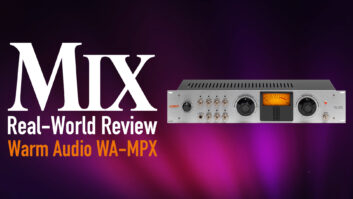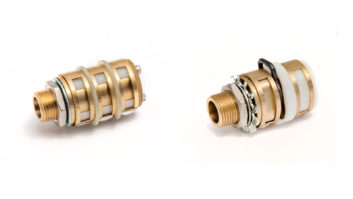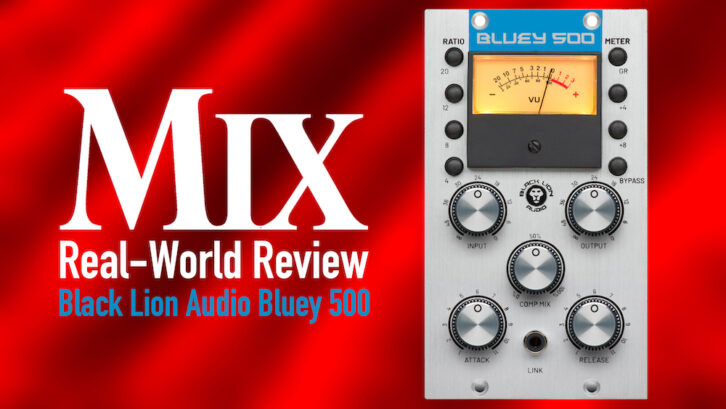
| MIX VERDICT: BLACK LION AUDIO BLUEY 500 |
| THE TAKEAWAY: “Whether you already have an 1176 or not, the little Bluey 500 fills the bill for vibey control on drums or most midrange elements.” |
| COMPANY: Black Lion Audio • www.blacklionaudio.com PRICE: $699 PROS: • Vibey, modified, aggressive-sounding and unique. CONS: • Quirks and too much input gain might be a problem for some. |
“Bluey” is music mixer Chris Lord-Alge’s affectionate name for his highly modified, silver-faced Universal Audio 1176 Rev A (aka, “blue stripe”) Limiting Amplifier. Rev A serial numbers ranged only from 101-125—UA 1176s were not black-faced until Rev C in 1970, when the “LN” suffix for low noise was added.
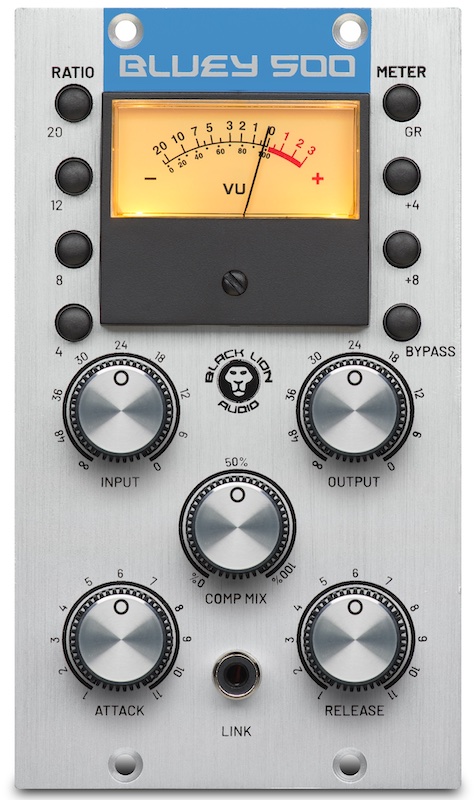
There are many discussions and arguments over which version of the 1176 sounds best, although the 1973 1176LN Rev D with serial numbers 1239 through 2331 black-face models are the most highly valued. I am fortunate to own a Rev D, and I did use it for some of the comparisons in this review, CLA owns four Rev A 1176LN units, but only one of the four is the actual “Bluey,” and sounds different from the other three. It is the one that has been used on 99 percent of the lead vocals in Lord-Alge’s music mixing work since the 1980s. He has many choices of compressor/limiters but has not been able to equal its particular sound quality and unique processing. This is likely because over the years, it was modified or repaired many times using incorrect, random or unknown parts, making it a one-of-a-kind processor that worked as no other 1176 possibly could.
BLUEY 500
Working with Lord-Alge, Black Lion Audio examined his 1176 Rev A and reverse-engineered it to produce a two-rackspace 1176 Bluey model (also now available). Based on that unit, the Bluey 500 fits in two slots of a 500 Series rack and is said to be exactly the same except, like all 500 module versions of rack gear, it runs on that system’s standard ±16-volt power supply rails.
Bluey uses CineMag transformers that copy the specifications of the original’s UTC input and Reichenbach output units, and Bluey 500 has many of the modern touches in the 2U model.
For one, there is the added input/output buffering circuitry, providing extra gain for directly inserting Bluey in a console insert point. I found this feature helpful during recording, when the output level (for whatever reason) of mic preamp/ EQ is low. Like any 1176, the Input control knob adjusts how much compression occurs; having extra gain here is useful when tracking.
Most significant and “newfangled” is the Wet/Dry control on the front panel. I liked that even with big squashes, I was able to dial back in some dry signal. I found this parallel processing especially useful for vocals and acoustic guitars.
You may stereo-link two Bluey 500s using a front-panel RCA jack and a short cable (not supplied) to another Bluey 500 in any slot in your rack. Not all racks support stereo linking, and some racks only work with single-slot size, side-by-side modules via their rear connectors. An actual stereo-link cable solves all those issues!
IN THE STUDIO
I recorded a Gibson J-28 acoustic guitar using a Warm Audio WA-MPX single-channel tube microphone preamp connected directly to the Bluey, no EQ. With Bluey’s extra input gain available, there was always a hot signal and plenty of adjustability; recording the softest finger-picking to hard strumming was no problem.
I used slow attack time and medium release time set to about the middle of the knob’s range. I saw up to -5 dB of gain reduction on the unit’s tiny VU meter using a ratio of 4:1. The sound was clear and present. It operates like any 1176, except for the additional input gain.
Austrian Audio OD5, OC7 and OC16 – A Mix Real-World Review
My first application as a line-level processor was as an insert in Pro Tools, as I wanted to compare Bluey with my 1176LN Rev D on different sources. I set Bluey to 100 percent wet and duplicated all the source tracks so I could insert my Rev D on one channel and Bluey on another channel. I wanted to try Bluey on all the tracks I would use my 1176 on during a mix.
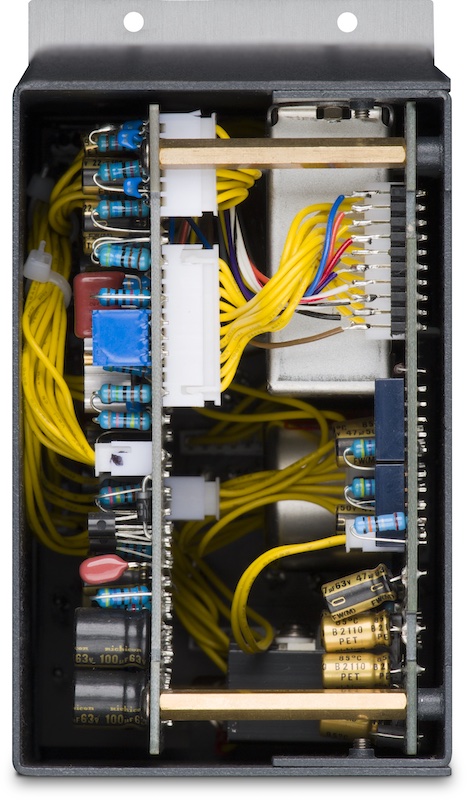
Because Bluey has more input gain, I would have to use an external line-level attenuator pad to take the level down about 15 dB, but I found using an adjustable Trim plug-in just ahead of the insert point on the channel was a better idea. The manual has nothing about all this, and I think this additional gain should be a switchable feature. Once I figured it out, I was ready to try Bluey on everything.
SNARE DRUM
The Attack time control on the Bluey works the opposite from my 1176LN. As pointed out in the manual, the fastest attack times (ranging from 20 to 800 uS) are full counter-clockwise, while on the original 1176LN, it is full clockwise. Release times are from 1.2 seconds to 50 mS, and the control works just like the original 1176. Nevertheless, how about marking the fast/slow extremes on the front panel?
For squashing a snare drum track, I used a 20:1 ratio and 100 percent wet. Attack time was at 2 o’clock on Bluey so that the bright attack of the stick hitting the drum was not softened greatly. The 1176LN’s Attack control was straight up by comparison.
Release time depends on the tempo of the song—I was watching the meter(s) wave back and forth with about 15 dB of gain reduction. If the release time is too slow, recovery of gain is incomplete, with the next snare drum hit reduced in level. Also, the live ambiance (room leakage) on the snare track will not be completely heard. Release time is important for compression effects!
I had the Input control on Bluey at maximum and the Trim plug-in set to -12 dB. I set my 1176LN to match Bluey as best as I could with the same Ratio, and similar Attack and Release times, duplicated by listening. The Input control on the vintage 1176LN was nearly maxed, and the Output was at 18 on the front panel.
The differences were audible, and I liked the way Bluey sounded more aggressive and intentional. Even though it was producing nearly the same effect, by contrast, my 1176LN was more “polite” and sedate-sounding, with a slightly warmer sound. Both proved useful in my mixes for different reasons, and it’s great to have the choice.
BASS GUITAR, LEAD VOCALS
My 1176LN’s cleaner sound won on bass guitar, although I would not normally use either compressor—my general preference is for a distortion-free and pristine bass sound. Opto- and/or VCA-based compressors are usually my choices here.
I wanted to try Bluey on both male and female lead vocals in various pop/ rock songs I was mixing—I wanted to channel CLA here! First, I inserted Bluey on a female R&B-style singer and achieved good control to keep the vocal up above without having to overpower the track in the mix. Bluey was set to a 4:1 ratio, slowest attack and release, and on vocal peaks, I saw about 15 dB gain reduction. I used some Dry side of the Wet/Dry control to regain some lost high frequencies without adding EQ.
On a particular male lead vocal, Bluey won with the ability to bring forward almost “thrown away” vocal bits and subtleties usually lost when the track’s pumping away. This made for less vocal riding required.
Whether you already have an 1176 or not, the little Bluey 500 fills the bill for vibey control on drums or most midrange elements—vocals, guitars or keyboards! It’s definitely worth checking out.





